by J. Kogen, B. Jakobs, F. Karlov [Shure Brothers, Inc. ]
IN 1966, we wrote an article for AUDIO entitled "Track ability." That article described the concept of trackability as the ability of the stylus to stay in contact with the record groove at all times during the playing of the record. It was emphasized that the necessity of maintaining contact between the stylus and the record is basic to phonograph reproduction and must be considered as one of the major factors in the evaluation of a phonograph cartridge. In the ensuing years, this concept has been accepted throughout the world, and measurements of trackability are made in one form or another by almost all testing laboratories.
During the years since that presentation, a continuous research program on trackability and allied subjects has been under way in the Shure laboratories. The work has been centered about three primary areas of activity. First, a means of accurately measuring the trackability of phonograph cartridges has been developed. This was described by Anderson and Jenrick in Audio (August, 1972), and a trackability test record, TTR 103, has been made available. Second, studies have been made on commercially available phonograph records to determine the trackability requirements that are imposed on the playback system. And, finally, a significant effort has been expended toward finding ways of improving the trackability of phonograph cartridges.
In this article, we will review the second and third areas of our investigative program. We will describe the results of measurements made on typical phonograph records. This, in essence, defines the tracking requirement imposed by the records, which must be accommodated by the playback system. We will then describe a design approach that satisfies these requirements.
Earlier Considerations of Trackability
The accepted definition of trackability has been: "The ability of the stylus to maintain contact with the record groove at minimum tracking force and at all frequencies within the audible spectrum."
This definition, which has been in use for many years, contains the term "audible spectrum." Our studies indicate that consideration must be given to frequencies outside the audible spectrum, and we will, therefore, modify the definition to: "The ability of the stylus to maintain contact with the record groove at minimum tracking force and at all frequencies found on phonograph records." The reasons for modifying the definition to include frequencies outside the audible spectrum will be discussed in detail later in this article.
In the 1966 article, reference was made to the limits of recorded modulation on records. In that reference, the audible frequency spectrum was broken down into parts and modulation limits applied as follows: A. Low frequency, extending from 20 to about 800 Hz, with a maximum amplitude of groove modulation of 0.005 centimeters (0.002 inches). B. Mid frequency, extending from about 800 to 2500 Hz, with a maximum modulation velocity of 25 centimeters per second. C. High frequency, above 2500 Hz, with an acceleration requirement in excess of 400 g.
These limits were determined by some theoretical considerations as well as practical limitations in cutting phonograph records. One of the practical limitations relates to the objective of providing a maximum playing time on each side of a record. This objective imposes a limitation on the amplitude of groove modulation. If the groove modulation is too large, it will not be possible to fit enough grooves onto the record to achieve this goal. In examining hundreds of records, we found that very rarely is the practical limit of 0.005 centimeters (0.002 inches) exceeded.
Another practical restriction is determined by the shape of the cutting stylus. The stylus is wedge-shaped (Fig. 1), and the relief angle between the sides and the front of the wedge determines the maximum angle the stylus is capable of cutting. This, in turn, determines the maximum modulation velocity to be found in the record groove. Near the inner grooves, this limit is about 25 centimeters per second. While higher velocities can be achieved with specially designed cutting styli and at larger distances from the center of the record, we have rarely found modulation velocities greater than 25 centimeters per second in the 800 to 2500 Hz frequency range.
A theoretical limitation in the high-frequency region is based on the assumption that records should not be cut with a radius of curvature of modulation less than 0.7 mils (0.0007 inches). The reasoning for this is that such modulation would cause excessive distortion when the record is played with a stylus having a tip radius of 0.7 mils. In 1966, we stated that many records had been found to exceed this theoretical limit. In the next section, we will review our most recent findings on this subject.

Fig. 1--Top view of cutting stylus in record groove. Fig.
2--Scatter diagram of "difficult-to-track passages" from
commercial records.
Tracking Requirements Imposed by Commercially Available Records in the AudibleFrequencyRange
A study was made of a large collection of "difficult-to-track" records in order to update our information on trackability requirements in the audible frequency range. The results of this study are shown in Fig. 2.
Many of the records included in this study were suggested to us by critics and customers, while others were discovered by our engineers. These records contain some of the most difficult-to-track passages found in phonograph records. The records are all of good quality, worth having in one's collection, but with characteristics that for one reason or another make them difficult to play. It was felt that this collection would constitute a reasonable sampling of problem records that a top-quality phonograph system should be able to reproduce with minimum distortion.
On each of these records, difficult-to-track passages were identified, and the modulation velocity and frequency for each passage were measured. Each of these measurements was then plotted as a point in Fig. 2. The envelope of the points presents a picture of the maximum recorded velocities found in this sampling of phonograph records illustrated as a function of frequency.
One point of information that should be interjected here is that some of the points in Fig. 2 would not appear to be difficult to track in terms of modulation velocity and frequency.
The measurements we have made assume single-frequency signals. Many of these passages actually contained a number of signals at different frequencies, the dominant one being present in Fig. 2. The total trackability requirement is actually the sum of those imposed by all of the frequencies acting simultaneously. It is also probable that the existence of warps in some of these records aggravated the tracking problem.
Superimposed on the scatter diagram of points in Fig. 2 are the "quasi" theoretical maximum velocity limits one would expect for recorded modulation velocity. Note that in the low frequency region, from 20 to 800 Hz, and in the mid-frequency region, from 800 to 2500 Hz, none of the measured points exceeds this curve. This is in agreement with the statements made previously regarding the 0.005-centimeter (0.002-inch) amplitude limit and the 25 centimeters-per-second velocity limit in the low- and mid-frequency regions. The theoretical high frequency limit is exceeded by many points, however, and it seems reasonable to assume that records have been and will continue to be cut with very high modulation velocities in the high-frequency region.
There are several reasons for the existence of high-velocity program material in the high-frequency region of phonograph records. High-frequency, high-level signals provide a means of broadening the dynamic range and producing impressive high frequency sounds from records. Also, no significant mechanical or electrical restriction is placed on the cutting equipment in this region. It is obvious from the points on Fig. 2 that cutters are capable of achieving very high modulation acceleration.
The only major restriction that the recording engineer apparently considers is the ability of the cutter to inscribe this high-level, high-frequency program material without "burning out" the equipment! The conclusion reached from the reexamination of track ability requirements in the audible frequency region is that the major problem area still lies in the high-frequency region. The theoretical limits in the low- and mid-frequency regions are reasonably well defined and held. In the high-frequency region, at this point in time, our objective appears to be one of maximizing trackability with no clear limit as to the maximum that must be achieved.
Evaluation of Commercially-Available Records—Sub-audible Frequencies
The tracking requirements imposed by the record can be significantly affected by the existence of warps and thickness variations in the record. Consider, for example, one of the difficult-to-track records we measured. The trackability requirement of the modulation in the record groove may be sufficient to drive the phonograph cartridge to the limit of its ability to play that modulation on a perfectly flat record. In such a case, all the available stylus force is used up just to play the groove modulation. Now, think of what will happen if the record is warped. In addition to being required to play the high-modulation velocity in the record, the cartridge must also follow the warp undulation. This will cause additional stylus force to be used up. The addition of the warp, therefore, could be enough to cause mistracking because of a lack of available stylus force. Since high modulation velocity and warp can and do happen simultaneously, it is very important for us to learn more about warp of commercially-available records.
Warp appears on records primarily in the form of sub-audible frequencies--that is, below 20 Hz. A study was performed to determine the amplitude as well as the frequency band in which warps occur. The method involved was to examine a significant number of randomly-chosen records by making measurements of the surface contour variations. These contour measurements were than analyzed to determine the amplitude and approximate frequencies of the warps.
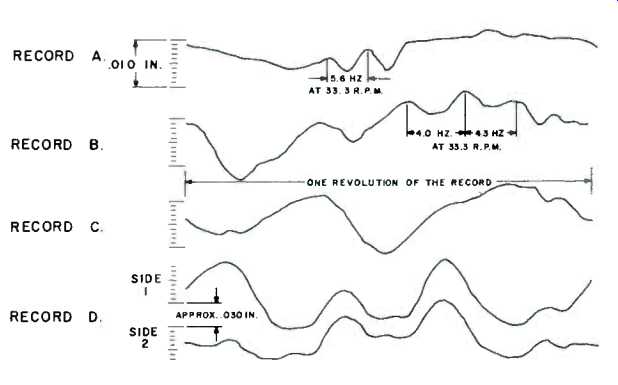
Fig.3--Examples of actual surface contours found on commercial phonograph
records.
A measuring technique was developed that provided a profile of the record surface as a function of angular position around the circumference of the record. Figure 3 presents a series of typical profiles. The vertical axis shows amplitude of the warps in thousandths of an inch; the horizontal axis shows angular position in degrees for 360 degrees around the record i.e., a full revolution. Figure 3 also shows several examples of frequency approximations, such as the section in record "A" around the 180-degree point, where an amplitude of about 0.005 inches and a frequency of 5.6 Hz are indicated.
Some of the records were measured on both sides, so that with proper alignment, thickness variation could also be determined. An example of this is shown in part "d" of Figure 3, in which the distance between the two curves indicates record thickness. In this particular record, there is a fairly significant variation in thickness. While it was found that thickness variations can be significant, their effect on disturbing the record surface profile is indistinguishable from warps as far as the playback problem is concerned. We will not, therefore, consider thickness variations as phenomena separate from warps.
In the study, 67 randomly-selected records were measured and 210 warp conditions were identified. Figure 4 is a scatter diagram that shows each of these points plotted at the appropriate amplitude and frequency. The dashed line across the bottom of the diagram represents the maximum recorded groove modulation amplitude limit-that is, 0.005 centimeters (0.002 inches). The solid curve lying above all the points represents the maximum expected warp amplitude based upon this random selection of records. The solid curve will be assumed to represent the worst warp conditions the playback system will be required to cope with in the range below 20 Hz.
The figure indicates that the warp amplitude increases as the frequency decreases. While we will not attempt to discuss this in detail here, another consideration is that of the probability that such warps will occur. In our study, we found that a large number of serious warps occur at frequencies around 4 Hz. This would indicate that although the maximum amplitude of warp occurs at the lowest frequency--that is, one-half Hz--the problem is really most significant in the region of approximately three to five Hz, where one must combine the problem posed by the amplitude of the warp along with the probability that such a warp will occur more frequently.
We should also state that the 67 records randomly chosen for this study were pressed within the past few years and include samples from most of the large record companies throughout the world. They should, therefore, be representative of the typical audiophile's record collection. The maximum warp curve of Fig. 4 could be subject to modification in the future if means should be developed for improving the flatness of records. We feel that for the present, however, this study gives us a reasonable, practical perspective of record warps and the challenge they present to the playback systems.
Trackability Requirements in the 0.5- to 20,000-Hz Range
The data shown in Fig. 4 can be used to present an extended low-frequency trackability requirement for phonograph cartridges. Figure 5 shows the trackability requirements extended into the subaudible region to encompass the warp frequencies.
The objective in the design of a phonograph cartridge must be to provide trackability that exceeds the limits shown in Fig. 5.
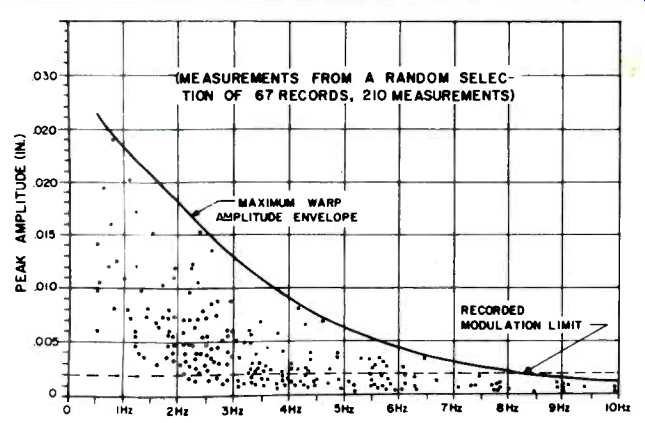
Fig. 4--Scatter diagram of warp amplitude and frequency found on commercial
records.

Fig. 5--Extended low frequency trackability requirements.
Several factors should be considered in attempting to meet this objective and also to provide the required high-frequency trackability.
In the very low-frequency region below approximately 100 Hz, trackability is determined by the tone arm and the phonograph cartridge operating as a system. In this region, track ability is not controlled solely by the cartridge as it is in the audible spectrum above approximately 100 Hz. We cannot specify trackability for the phonograph cartridge alone but must consider the cartridge in combination with the tone arm.
Above approximately 100 Hz, trackability is determined solely by the phonograph cartridge. In phonograph cartridge designs, it is possible to "trade off" trackability in the low frequency region in order to increase trackability in the high frequency region. It is possible to provide only enough low frequency trackability to satisfy the low-frequency requirements and to place the major emphasis in the high-frequency region. The design is wasteful, to say the least, if excessive low-frequency trackability margin is provided with a resulting reduction in high-frequency trackability.
Since recorded modulation at all frequencies and warps can occur simultaneously, it is necessary that the cartridge arm system be able to track properly throughout the total significant frequency band. It is not sufficient for the cartridge-arm system to be capable of tracking audio frequencies and yet be incapable of properly coping with the warp modulation. The objective in the design of the phonograph cartridge must be to resolve both of these problems at the same time.
Optimizing for Low-Frequency Trackability
In the low-frequency region, the amplitude of the record groove excursion caused both by the recorded groove modulation and by the warp of the record is the major factor to be considered. In order to track in the low-frequency region, it is necessary for the stylus to be capable of deflecting to the maximum amplitude with the available tracking force.
At low frequencies, this ability is determined primarily by a parameter that we call the dynamic compliance of the stylus.
The compliance figure normally specified for phono cartridges in "10^-6 centimeters per dyne" is the static compliance; that is, the compliance that would be measured under static conditions. Dynamic compliance is measured while the stylus is in motion and is normally smaller than the static compliance.
At some low frequency, the tone arm-cartridge system will exhibit a resonance determined primarily by the interaction of the dynamic compliance of the stylus and the effective mass of the tone arm-phono cartridge combination. At and near the resonance frequency, the motion of the stylus relative to the tone arm will be many times that of the exciting signal. This will then significantly reduce the ability of the pickup to track the groove modulation. It is essential, therefore, that we minimize as far as is practical the probability of exciting this resonance.
To further examine the effect of tone arm-cartridge resonance, let us consider an experiment as depicted in Fig. 6. Here we have a tone arm and cartridge mounted with a device that can drive the stylus at a constant amplitude with varying frequency. Such a device could be the coil-magnet assembly of a loudspeaker. We will measure the output of the phonograph cartridge as the frequency is varied from a very low frequency up to 100 Hz. We will assume for the purpose of this example that this particular system resonates at 10 Hz.
At one-half Hz, the tone arm and cartridge move up and down together as a unit. There is little relative motion between the stylus and the tone arm. Since the stylus moves only slightly with respect to the tone arm, little electrical signal is generated and we can plot point 1 of Fig. 7.
As the frequency of the input signal is raised, we begin to discern more relative motion between the stylus and the tone arm. Keep in mind at this time that the total system is moving up and down with the driving device, and we are now obtaining an additional motion of the stylus relative to the tone arm. This produces some output, as shown at point 2 of Fig. 7.
As the system approaches resonance, the tone arm moves in ever-increasing amplitude, reaching a violent motion at 10 Hz. There is considerable relative motion between the stylus and the tone arm, and considerable electrical output from the cartridge (point 3, Fig. 7). This is the resonance frequency.
As the frequency is raised above 10 Hz, the relative amplitude of motion between stylus and tone arm decreases, and at about 40 Hz becomes constant with increasing frequency.
At this point, the tone arm is standing still and all of the motion is taking place in the stylus. This is the condition under which the phonograph system is supposed to operate in the recorded frequency range. At these frequencies, one cannot see movement of the stylus with the naked eye.
There are two very important observations to be made from this experiment. First, the movement of the cartridge-tone arm system at and around resonance can cause considerable difficulty in tracking, and the frequency at which this resonance occurs must be determined with great care. Second, motion of the cartridge-tone arm below, say, 20 Hz is an indication that the system is having some difficulty. It is important to minimize the possibility and probability of generating such motion.

Fig. 6--Method for measuring tone arm-cartridge resonance.
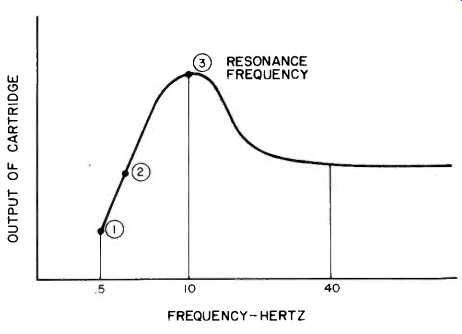
Fig. 7--Output of cartridge as drive frequency is changed near tone arm-cartridge
resonance.
Optimizing the Resonance Frequency of the Cartridge-Tonearm System
The optimum resonance frequency for the cartridge-tonearm system can be deduced from Fig. 5. The figure shows that the minimum amplitude for warp and recorded groove modulation is in the region around 10 Hz. By measuring the cartridge-tone arm system at low frequencies in a manner similar to that just described, we can determine the low-frequency trackability of the system. A typical low-frequency cartridge-tone arm track ability curve is shown in Fig. 8, which also repeats the warp and recorded groove modulation velocity requirements of Fig. 5. In order to optimize the system, we should place the point of minimum trackability (the resonance frequency of the tonearm-cartridge system) in the region of minimum warp and record modulation velocity; that is, around 10 Hz.
The two major factors that affect the resonance frequency are the mass of the tone arm-cartridge system and the dynamic compliance of the stylus. Increasing the mass of the system will lower the resonance frequency and tend to raise the amplitude of the resonance, or, conversely, decrease the trackability. Increasing the dynamic compliance will also decrease the resonance frequency. By adjusting these two parameters, one can find an optimum frequency for the minimum point of the track ability curve. This optimum frequency is in the range between 7 and 15 Hz where there is a minimum of groove modulation and warp input to excite system resonance.
From the standpoint of phonograph cartridge design, it is necessary that the cartridge be made to operate with available good quality tone arms. A survey of tone arms indicates that the effective mass can be expected to fall in the range of 13 to 30 grams. (This includes typical cartridge mass.) This, then, sets a definite restriction on the dynamic compliance of the cartridge.
Using the information obtained as to the optimum resonance frequency and the range of effective tone arm masses, we can calculate the optimum dynamic compliance for a phonograph cartridge to be in the range of 20 to 25 micro-centimeters per dyne (10-6 cm/dyne).
The conclusion we have reached is most significant with regard to optimizing the design of a phonograph cartridge. We have found that there is actually an optimum compliance, and that either too much or too little compliance can lead to difficulty.
If the compliance is too high, the resonance frequency of the tone arm-cartridge system will be too low; and severe problems will result when the system is used with warped records. Aggravated wow and groove jumping are typical in this case. In addition, large amplitude, sub-audible electrical signals will be generated. The signals can easily overload an amplifier or cause excessive stress and possible distortion in the loudspeaker.
If the stylus compliance is too low, causing the resonance frequency to be too high, several other problems can occur. Very low audio frequencies may be over-emphasized because of the rise in response near resonance. One might also expect increased mechanical and acoustical feedback problems. And, finally, problems may occur because of insufficient low-frequency trackability in the audio region.
The seriousness of the low-frequency resonance problem should not be underestimated. We have found that the sensitivity to record warp resulting in mistracking and wow can differ by as much as a factor of ten between properly and improperly designed tone arm-cartridge systems.
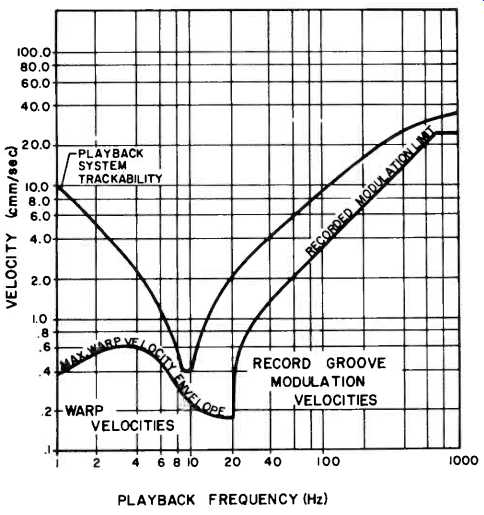
Fig.8--Typical tone arm-cartridge trackability curve.
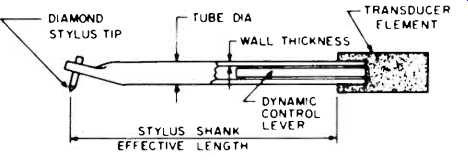
Fig.9--Stylus of Shure phonograph cartridge.

Fig. 10--Mechanical, electrical, and effective frequency characteristics
of V 1 5-I.
Optimizing for High-Frequency Trackability
The need for maximizing high-frequency trackability has been established (Fig. 2). Our objective in the high-frequency region is to obtain all the trackability possible, provided that we have allowed sufficient tracking capability in the sub-audible, low-, and mid-frequency regions. The studies that yielded the data illustrated in Fig. 2 give information as to the required trackability for the cartridge. Other studies relating to evaluating cartridges, as reported by Anderson and Jenrick in AUDIO (August, 1972), resulted in the TTR103 Test Record, which is now commercially available. This record allows measurement of trackability in the low-, mid-, and high-frequency regions. The remaining and most critical objective is to determine how to design a cartridge that will satisfy the known trackability requirements.
The major factor in maximizing high-frequency trackability of the cartridge is the design of the stylus. When studied in detail, the stylus is a complex mechanical structure. In previous papers, this subject was discussed in some detail, and we will not repeat that information here. Suffice it to say that development and design engineers must pursue a task of considerable complexity, using both analog and digital computational techniques, along with arduous and painstaking development and evaluation of prototypes. Parameters that must be optimized include many stylus dimensions; stylus shank, wall size and thickness; tip shape and size; magnet geometry; different materials; and--in the case of the Shure cartridge-dimensions and positioning of the dynamic control lever (Fig. 9). The general direction in which the engineer moves is that of decreasing the effective stylus mass.
However, there are many limitations on this objective, not the least of which is ruggedness and reliability. Output level and clearance between the cartridge and the record surface are other factors that must be considered when reducing the stylus mass.
While one primary objective is to maximize high-frequency trackability, we must not forget other very important characteristics of the phonograph cartridge. It is possible to improve trackability, but at the same time deteriorate the frequency response. There is a point beyond which this is not acceptable. A brief historical review will be useful to explain this point.
The frequency response of a phonograph cartridge results from the combination of two frequency characteristics: the mechanical characteristic of the stylus and the electrical characteristic of the cartridge. Figure 10 shows these characteristics for the original Shure V-15 I phonograph cartridge, which was introduced in 1964. In the figure, we show the effective frequency response, as well as the relative responses of both the stylus and the cartridge alone. Addition of the mechanical and electrical curves results in the effective response. Since trackability is generally poor at resonance, it is clear that the V-15 I would have difficulty tracking material in the 15 kHz region.
Trackability of the Shure V-15 II cartridge was substantially improved by moving the mechanical resonance frequency to 20 kHz while many other parameters of the cartridge were idealized. In the design of the V-15 II, the decision was made to accept a small droop in the frequency response in exchange for the vastly improved trackability. This is shown in Fig. 11.
In the development of the newly introduced Shure V-15 III (Fig. 13), one primary objective was to further improve the high-frequency trackability. In the process of making this improvement, the stylus resonance was moved out to 23,000 Hz, well above the audible spectrum. It was clear, however, that with this additional raising of the resonance frequency, a considerable droop in the frequency response curve would occur if the cartridge body of the V-15 II were retained. It was thus necessary to design a completely new cartridge body structure to match the higher trackability stylus of the V-15 III. The cartridge structure of the V-15 III incorporates an assembly of precise miniature laminations. These laminations reduce electrical losses in a manner similar to the laminations of an electrical transformer. Through the use of these ,laminations and several other design features, it is possible to provide an electrical frequency response that almost perfectly complements the mechanical frequency response of the stylus.
This results in an overall frequency response that is essentially flat (Fig. 12). Through the use of this new structure, it is possible, therefore, to achieve a significant improvement in high-frequency trackability and, at the same time, to provide an improvement in frequency response over that of the previous design-the V-15 II. The trackability curve of the V-15 III as compared to the V-15 II is shown in Fig. 14.

Fig. 11--V-15-II frequency response characteristics.
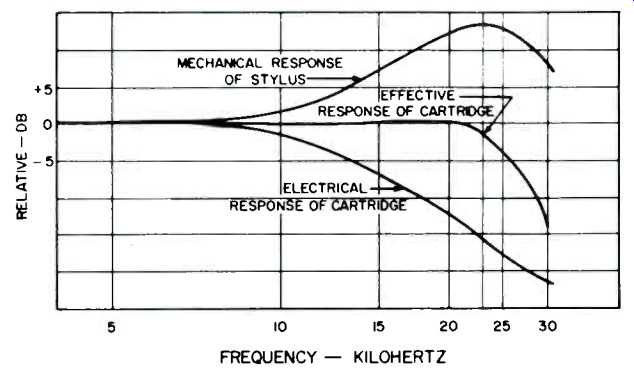
Fig. 12--V-15-III frequency response characteristics.
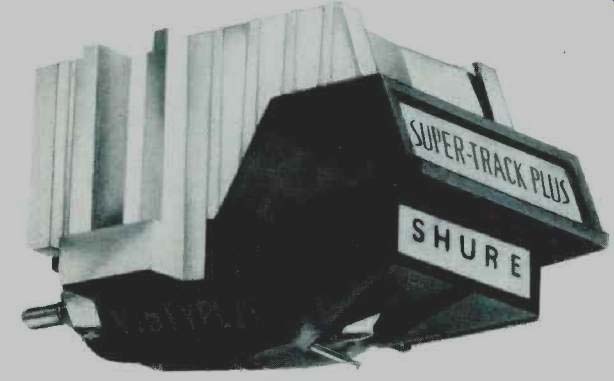
Fig. 13--V-15-III
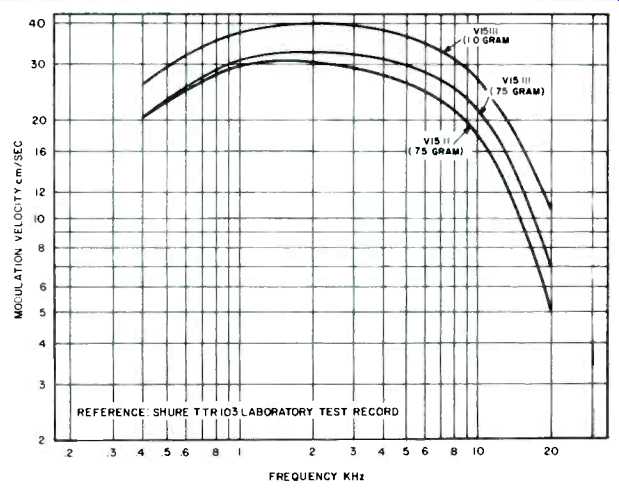
Fig.14--Trackability of V15-II and V15-III.
Conclusion
New product development must always be a matter of continuous progress. In many instances, however, we must retrace our steps, reexamine our previous results, and provide improvements before moving ahead. While such factors as record warp and thickness variations, and high-velocity groove modulation have been known to us for many years, we have found it valuable to learn more about them. We have learned about them by developing measuring techniques and by performing extensive studies, both on discs and on cartridges.
Our measurements show that warp is a significant problem in current phonograph records and that it is essential to optimize the dynamic compliance of a phonograph cartridge so that records may be played properly. Since warp exists on practically all phonograph records to one degree or another, it is an important characteristic that cannot be ignored. Fortunately, we know how to minimize the effects of warp without compromising the low-frequency response. Only severely warped records need cause significant problems.
We have also learned that through careful optimization, it is possible to design a phonograph cartridge that satisfies the high-frequency tracking requirements of practically all phonograph records and, at the same time, offers an almost perfect, flat frequency response. The art and technology of making records has progressed significantly since the report we presented in Audio in 1966. We believe that the design of phonograph cartridges and their ability to play the records has kept pace with that progress.
(Audio magazine, Aug. 1973)
Also see:
From The Ortofon Test Record Library (Mar. 1974)
The Phono Cartridge Electrical Output Network (March 1981)
Which Tracks Best--A pivoted or a radial Tonearm? (June 1982)